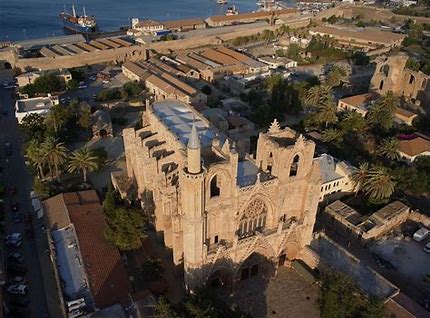 The Notre Dame of Cyprus, St. Nicholas Cathedral, is used as a mosque in the northern part of the country, which has been illegally occupied by Turkey for nearly 50 years.
The Notre Dame of Cyprus, St. Nicholas Cathedral, is used as a mosque in the northern part of the country, which has been illegally occupied by Turkey for nearly 50 years.
St. Nicholas, the most majestic structure in Famagusta, was constructed between 1298 and 1312 in the Gothic style. Kings of the House of Lusignan went to this church to be ceremonially crowned Kings of Jerusalem after they had been crowned as Kings of Cyprus in the St. Sophia Cathedral (now Selimiye Mosque) in Nicosia.
However, the Cathedral was transformed into a mosque with the addition of a mihrab and a minaret and renamed the “Lala Mustafa Pasha Mosque” in 1954, after the commander of the 1570 Ottoman attack against Cyprus.
“In 1570 the Ottoman invasion which took Nicosia, then Famagusta, in hideous and bloody sieges, marked the end of the natural life of the edifice as a place of Christian worship,” according to Michael Walsh, a professor of art and archaeology.
source : Greekcitytimes.com
courtesy of Rita Mahdessian, lawyer—————————-
Il apparaît que la principale source d'inspiration des bâtisseurs de la cathédrale de Famagouste est la cathédrale Notre-Dame de Reims (1211–1275) en tant que lieu de couronnement des rois de France, alors que Saint-Nicolas est destinée à accueillir la cérémonie de couronnement des Lusignan, rois de Jérusalem1. Certains détails, particulièrement le chevet, rappellent aussi la basilique Saint-Urbain de Troyes (1265) qui est un exemple de style gothique plus avancé et gracieux1. La façade ouest est typique du gothique français. Le style de l'édifice est très homogène, à l'exception de quatre chapelles ajoutées sur les bas-côtés à une époque postérieure1 et du minaret construit sur l'une des tours après la transformation de l'édifice en mosquée. Les têtes humaines et d'animaux de la plus grande partie des sculptures ont été détruites, mais quelques-unes subsistent dans les parties les plus inaccessibles2.
- source : wikipedia


